


 |
December 22-28: Christmas in North Carolina |
 |
November 18-23: A Trip to Paris, France |
 |
Return to Index for 1980 |
After my few days in France, I flew from Paris to Amsterdam- on my birthday, as it turned out. Knowing what I know now, it would have been more convenient, although longer, to take the train. But, I didn't count on the time to get to Orly, board the plane, fly back to Schipol and then take a taxi to the hotel. The train would have been easier.
|
I find this continually interesting in my travels, whether it be to the ends of the earth to see Sugarloaf in Rio, or simply to San Francisco to see the cable cars; I think it is always interesting when I am able to see, for real, objects and scenes that I have seen innumerable pictures or movies of before. I count myself very lucky to have had all these opportunities.
The client I was here in Amsterdam to work for was Merck, the pharmaceutical company, which is actually a division of a large international company- Merck, Sharp and Dohme. One of their major offices is in Amsterdam; they have their warehouse operation there for all of Europe. They wanted an SSAD class here, and I would be teaching it at their "high-bay warehouse"- a partially automated facility in the suburbs of Amsterdam.
I was met at Schipol by one of the Merck employees, who drove me to the Apollo hotel- the hotel they had recommended. The Apollo is a very nice hotel not quite in the center of Amsterdam, but still well within the city. It is situated within walking distance of most of the attractions of Amsterdam, and it was convenient for the Merck employee who picked me up each day to drive me to the warehouse facility.
|
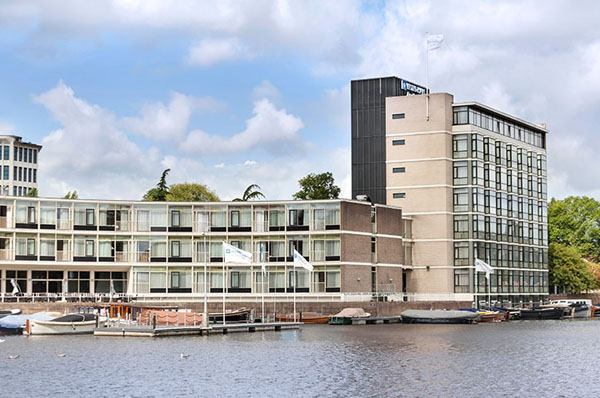 |
At left, above, is a promotional view of the hotel as it looks today, taken from their website. You'll be able to see that my own pictures of the hotel show that it hasn't changed much. The Apollo Hotel Amsterdam is a four-star hotel in the Apollolaan District of Amsterdam-Zuid, Netherlands. The hotel has 223 rooms and a restaurant, La Sirène. Located on the North Amstel Canal, it has a private marina near the confluence of five canals.
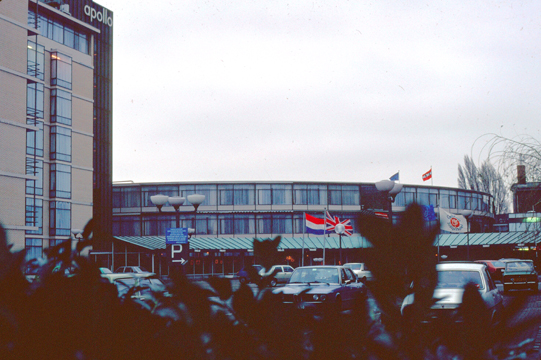 It was Sunday, the day before the class was to start, and it was overcast and quite chilly. |
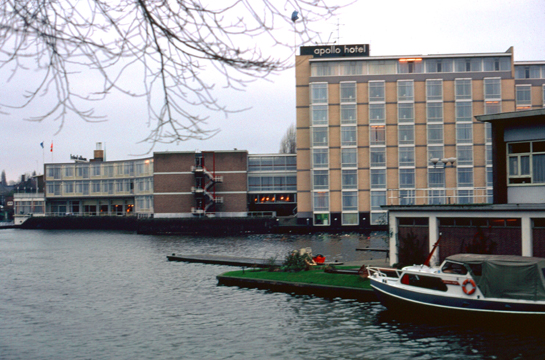 After checking in, I walked down one of the waterways nearby to get this view of the hotel. |
The Apollo Hotel originates from the bar and restaurant Apollo Pavilion at Apollolaan and the South Amstel Canal, opened in 1934. Both the pavilion and the sports complex next door, the Apollohal, were designed by Albert Boeken, and were historic sites. In 1962 the pavilion was expanded to become the 65-room Apollo Hotel, and there were two later expansions in 1969 and 1974.
|
Everything was just like an American hotel; our standards have become very pervasive throughout the world. The only odd thing is the electricity; I had a razor and hair dryer and I had to order a converter from the front desk. I expected a small electronic device, but I got a eight inch by eight inch cubic mechanical device, the cord of which plugged into the wall and which had another socket for my appliance on the other side. I had to set it on the desk and use the appliances in front of the bedroom mirror.
It was Sunday, so I thought I would go out and walk around to see what I could see; I didn't think I would have much time during the week and I would be leaving for home on Saturday.
The map of the southern (Zuid) portion of the city at left shows you where the hotel is located and the approximate route I took as I walked into the center of town. The path took me to the Rijksmuseum, the Netherland's most famous museum, and all the way north to the center of town and Muntplein Square.
The Apollo Hotel is right on a small river that runs through Amsterdam. As you know, Amsterdam is a city of canals, something like Venice, but with much more land area and less water. However, there are lots of bridges and waterways, and lots of people and businesses have water frontage. I began by walking north from the Apollo Hotel, immediately crossing a canal so I could head on into the city.
|
If you went out the hotel driveway and turned left, though, you are in a purely residential area. It was a very nice area, as these houses that border the same waterway as the hotel indicate. This is where I did my jogging in the afternoons. I found a section of six square blocks that did not have a major street running through it, and this rectangular area had complete sidewalks, so I could run around it much as you would run around a track, and be relatively certain of not stepping off a curb and trying to cross a busy street. This was good, because by the time I was dropped off from work, it was pretty dark.
The area was heavily tree-shaded, which made it a bit more gloomy when I was out jogging. It was late November, and getting pretty cool in Amsterdam; my sweatshirt was almost insufficient for jogging.
I wish the weather had been nicer for this one opportunity I had to go out walking in the daytime. Later in the week, the weather cleared for a few days, and if I'd had a chance to take a walking tour then, the pictures would have been better.
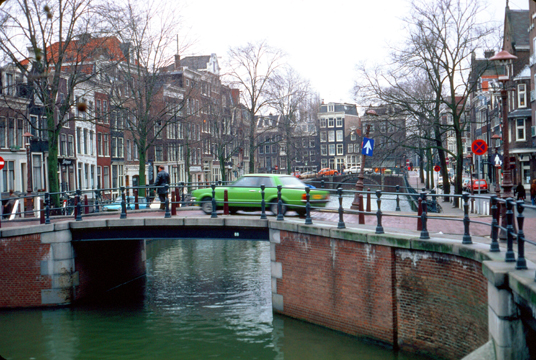 The multitude of canals and bridges make the city very picturesque, although it can be something of a chore, I guess, to go visit your neighbor across the street. |
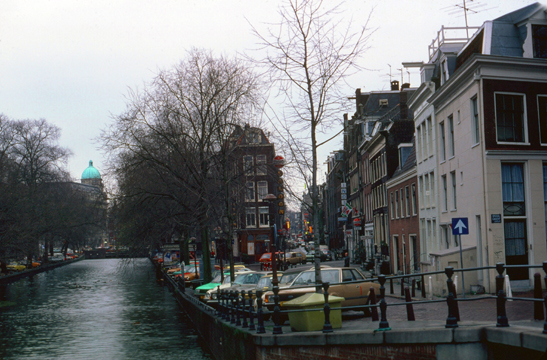 This is another typical scene along one of the waterways. Again, note the similarity of all the buildings in this section of Amsterdam. |
As I walked towards the center of Amsterdam, I found myself, almost by accident, right by the Rjiksmuseum; having not only heard about it but studied many of the artwork it displays in college, I couldn't pass up the opportunity to go in.
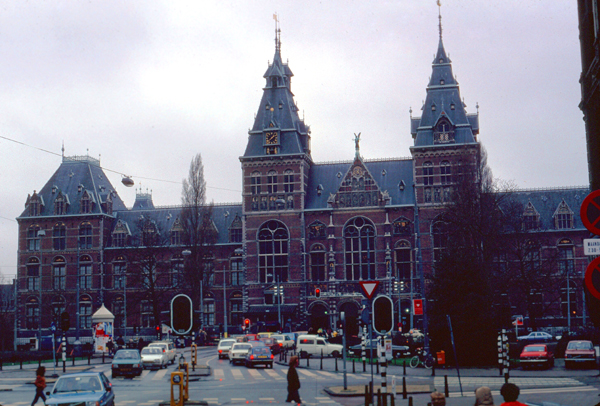 The Rjiksmuseum in Museum Square |
The museum has on display 8,000 objects of art and history, from their total collection of 1 million objects from the years 1200–present, among which are some masterpieces by Rembrandt, Frans Hals, and Johannes Vermeer. The museum also has a small Asian collection, which is on display in the Asian pavilion.
The museum began with a collection of 200 paintings and historic objects from the collections of the Dutch stadtholders. When the Kingdom of Holland was established in 1806 (by Napoleon Bonaparte), the museum moved to Amsterdam, and the paintings owned by that city, such as The Night Watch by Rembrandt, became part of the collection. Through the 1860s, the fragmented collection resided in inadequate spaces, so a design contest was held for a new building for the Rijksmuseum. The winning design was a combination of gothic and renaissance elements. Construction began in 1876 and the new museum opened in 1885.
When traveling, I am more interested in seeing sights, and so consider spending precious time in a museum to be something of an extravagance, so I didn't spend a great deal of time in the Rjiksmuseum. I did, however, want to see what is arguably its most famous item on display.
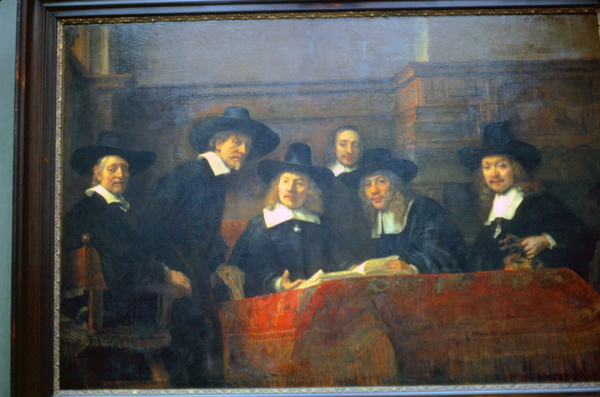 The Sampling Officials by Rembrandt |
The men (with the exception of Bel who is an attendant as indicated by his calotte) are drapers who were elected to assess the quality of cloth that weavers offered for sale to members of their guild. Their one-year terms in office began on Good Friday and they were expected to conduct their inspections thrice weekly. The inspectors used pliers to press the seals of their city (front) and guild (reverse) into penny-sized slugs of lead that were specially affixed to record the results of the inspection. There were four grades of quality, the highest was indicated by pressing four seals and the lowest by pressing only one.
The men, who are appraising a length of Persian-style fabric against exemplars from a swatch book, are (from left to right), Jacob van Loon (1595–1674), Volckert Jansz (1605 or 1610–1681), Willem van Doeyenburg (ca. 1616–1687), Frans Hendricksz Bel (1629–1701), Jochem de Neve (1629–1681), and Aernout van der Mye (ca.1625–1681). The guild commissioned this portrait and it hung in their guildhall- the Staalhof- until 1771. But I said that even if you didn't know anything about the painting, the one thing you did know is that you'd seen it before. Few outside the art world had seen the painting until it was used on the packaging of Dutch Masters cigars.
Coming out of the museum, the weather was a bit better, and I continued on towards the center of town.
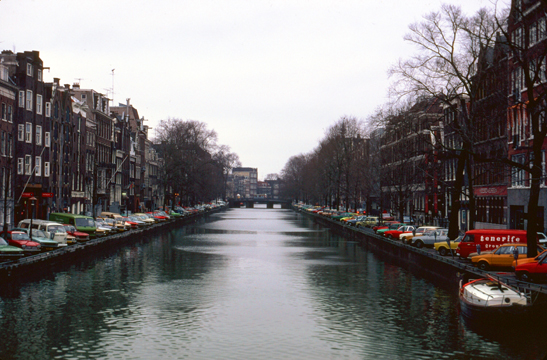 Here is another typical waterway scene. It is very common for the parking to be allocated by the water, with the street and houses beyond. |
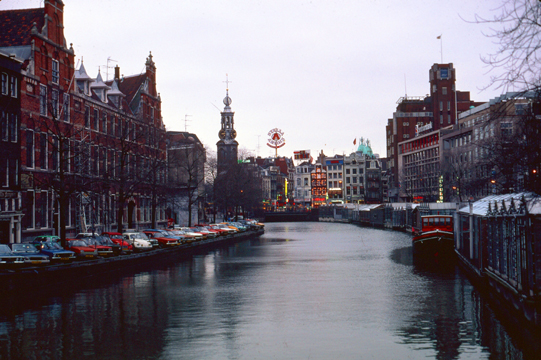 Closer to town, the scenery changes little, except there are more cars and commercial buildings. There must be an access out of the canal system for the boat that you see here. |
I noticed that many of the parking spaces seem to be reserved for either residents of the building right across the street, or any resident of that street. I think I saw little decals on the cars which would indicate that they were residents of that street or of that neighborhood. For all the waterways, I saw relatively few boats. That is probably because there are so many low bridges that access to the inner canals would be impossible for most craft-except low boats like this barge-like craft here.
|
The Muntplein (literally "mint square") is just about the center of Amsterdam (at least the older part). The square is in fact a bridge— the widest bridge in Amsterdam— which crosses the Singel canal at the point where it flows into the Amstel river. All bridges in Amsterdam are numbered, and the Muntplein carries the number 1.
Muntplein is named after the Munttoren (or simply "Munt") tower which stands on this square. This tower was once part of one of the three main medieval city gates. In the 17th century, it temporarily served as a mint, hence the name. The guard house building attached to the tower is not the original medieval structure but a late 19th-century fantasy. An underpass was added to the building during a 1938–1939 renovation.
The name "Muntplein" dates from 1917. The square was originally known as Schapenplein ("sheep square") and, from 1877 to 1917, as Sophiaplein (after Queen Sophia, first wife of William III). The square is a bustling intersection of six streets. It forms the southern end of the Kalverstraat shopping street and the major street Rokin. The eastern end of the floating flower market (Bloemenmarkt) along the Singel canal is directly south of the square. Six tram lines Muntplein, making it a major transportation hub. I understand that the square is quite beautiful in the spring and summer when the weather is nice; I am sure the flower market is amazing at that time of year. I took the picture above from a point out of the aerial view to the right.
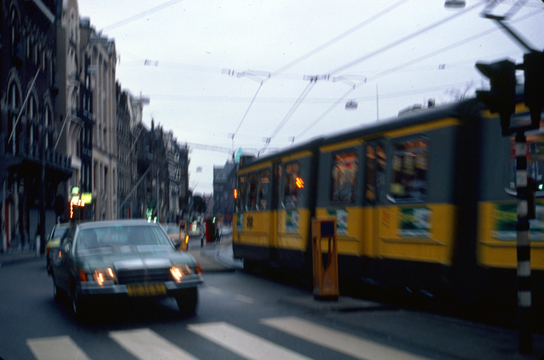 Away from the waterways, the streets have a definite European flavor. Everything just looks a little foreign (although these streetcars look exactly like the Muni streetcars in San Francisco). (Sorry the picture is out of focus) |
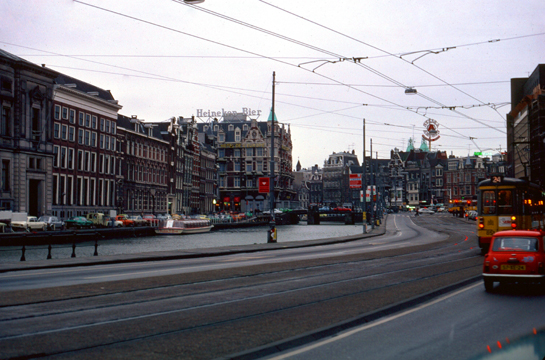 This picture was taken near the center of the city. Off to the left is most apartments and very small offices, and there is shopping to the right. Note the overhead electric wires for the streetcars. |
The streetcars are very convenient; the lines run down all the major streets within the city. I don't think they go very far out to the suburbs; there seem to be a fair number of automobiles in Holland, so I suppose that people who live far out have one, and just use the streetcars to come into the center of the city. The fare was about fifty cents, and they ran fairly frequently. It is confusing, though, for the drivers, to know just when they can drive on the tracks, how to make left turns when there is a streetcar coming, and so on. Fortunately, I did not drive in Amsterdam so I didn't have to learn the rules.
|
I did a bit of walking around in the evenings after class, and spent two nights down in the main shopping district, which stays active until about ten o'clock. I was lucky enough to run across a Baskin-Robbins store to add to my list; as in France, I did not seem to find them in the telephone book. So there may be more, and if I get back again I will have to try to find them. I must also say that I spent one evening walking around the "red light district," for which Amsterdam is famous. To all the opponents of legalized prostitution in this country I can only say that they should go and see how civilized, neat, clean and well-run "houses of ill-repute" can be when the state recognizes the inevitable, and, instead of legislating against and trying to eliminate, takes the view that what people are going to do anyway should at least be controlled and licensed.
The class ended on Friday, November 28th, and on Saturday I went out to the airport to get my flight back to Chicago. KLM was the airline that Steve put me on, and this is the 747 that I was to take home.
You can use the links below to continue to another photo album page.
 |
December 22-28: Christmas in North Carolina |
 |
November 18-23: A Trip to Paris, France |
 |
Return to Index for 1980 |